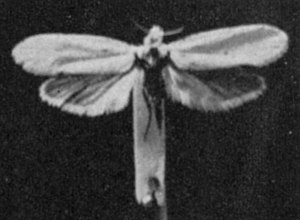Yuccamots
| Prodoxidae | ||||||||||||
|---|---|---|---|---|---|---|---|---|---|---|---|---|

Prodoxidae |
||||||||||||
| Systematics | ||||||||||||
|
||||||||||||
| Scientific name | ||||||||||||
| Prodoxidae | ||||||||||||
| Zeller , 1873 |
The yuccamoths or rose-leaf sac moths (Prodoxidae) are a family of butterflies (Lepidoptera). Of them, only about 80 species in two subfamilies are known worldwide, 18 occur in Europe , 14 of them also in Central Europe . They are most closely related to the miniature sac moths (Incurvariidae) and the Cecidosidae .
features
The small moths have very narrow forewings with a length of 4 to 16 millimeters, with a wingspan of 9 to 35 millimeters. They differ from the other families of their superfamily in three characteristics of the females. The most important distinguishing feature is a pair of star-shaped signs ( sclerotized processes ) on the sperm chamber ( corpus bursae ) of the female genitals. Furthermore, the rear of the sternum of the seventh abdominal segment is strongly rounded and the tergum of the same segment is triangular.
In addition, the animals have stunted but large mandibles , the maxillary palps are elongated and three to five-limbed and the labial palps are short and directed either upwards or forwards. In most species these have three members, only in those of the genus Parategeticula they are two-membered. The proboscis is out in the genus Lampronia long, in the genus Tridentaforma he beschuppt what otherwise only species within the family of adelidae is known (Adelidae). The antennae are filiform and 0.33 to 0.6 times as long as the fore wings. The wings usually have no shiny metallic areas.
The caterpillars are 6 to 22 millimeters long and have a white, green or reddish body color. The head capsule is colored light to dark brown. The thoracic lines are mostly trained, they are absent in the genera Agavenema and Prodoxus . However, the abdominal legs are reduced or completely absent. The wreaths of hooks on the abdominal legs are also usually missing; they are rarely formed from the third to sixth abdomen segment and form a diagonal row there.
Occurrence
The yuccamot family is known almost exclusively from the Holarctic , with the majority of the species occurring in the Nearctic . In addition, species can also be found in southern Argentina and Chile .
Way of life
The caterpillars live as bores within the shoots, leaves, flowers, buds, fruits or seeds of the food plants, some species spin leaves together, between which they live. The endophage life is an adaptation to the populated by many types of semi-arid and arid areas. The two subfamilies Lamproniinae and Prodoxinae are mainly distinguished by the way the caterpillars live. Those of the former feed on the fruits of the rose family and saxifrage family . They overwinter in a hibernaculum in the ground or at the base of the food plant before they drill into the plants again the following spring. The caterpillars of Lampronia fuscatella live in plant galls . Pupation takes place in a cocoon , which is either placed on the outside of the food plants or in the feeding tunnels. The caterpillars of the Prodoxinae mainly drill into the seeds or stems of agave plants . In the two genera Tegeticula and Parategeticula , the female moths ensure the progress of their species by pollinating the flowers of the food plants. Pupation takes place in a cocoon either in the ground or in the feeding tunnels.
The females lay their eggs in the plant tissue. In most species, one generation is formed per year, the adults of the new generation usually hatch in spring or early summer. Since their food plants sometimes bloom irregularly, some species of the Prodoxinae can take unusually long diapause , which in Prodoxus y-inversus can last over 20 years.
Species (Central Europe)
- Lampronia capitella (Clerck, 1759)
- Lampronia corticella (Linnaeus, 1758)
- Lampronia flavimitrella (Huebner, 1817)
- Lampronia fuscatella (Tengström, 1848)
- Lampronia intermediella (Heinemann, 1870)
- Lampronia luzella (Huebner, 1817)
- Lampronia morosa Zeller, 1852
- Lampronia provectella (Heyden, 1865)
- Lampronia pubicornis (Haworth, 1828)
- Lampronia redimitella (Lienig & Zeller, 1846)
- Lampronia rupella (Denis & Schiffermüller, 1775)
- Lampronia splendidella (Heinemann, 1870)
- Lampronia standfussiella Zeller, 1852
Non-European species (selection)
- Tegeticula yuccasella (Riley, 1872)
swell
Individual evidence
- ↑ Prodoxidae. Fauna Europaea, accessed February 13, 2008 .
- ↑ Prodoxidae. Lepiforum eV, accessed on February 13, 2008 .
literature
- Niels P. Kristensen: Lepidoptera, moths and butterflies . In: Maximilian Fischer (Ed.): Handbook of Zoology . 1st edition. tape 4 - Arthropoda: Insecta , volume 35. de Gruyter, Berlin / New York 1998, ISBN 3-11-015704-7 (English).
- Malcolm J. Scoble: The Lepidoptera: Form, Function and Diversity . Oxford University Press, Oxford 1995, ISBN 0-19-854952-0 (English).
Web links
- Tree of Life web project (English)
